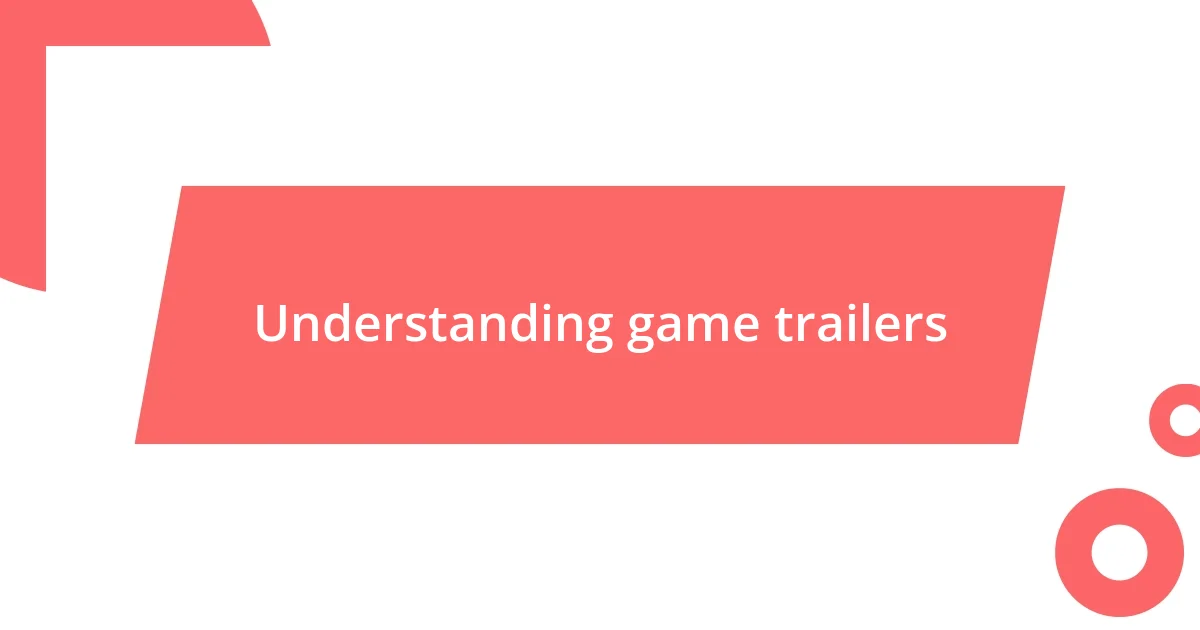Key takeaways:
- Game trailers blend art and marketing, evoking emotions through pacing, editing, music, and sound design, which influence viewers’ perceptions and excitement.
- Analyzing trailers reveals storytelling layers, character depth, and creative choices that enhance appreciation and anticipation for games.
- Key elements to observe include character design, environment depiction, editing style, and gameplay mechanics, all contributing to the overall emotional impact and connection to the narrative.

Understanding game trailers
Game trailers are an intriguing blend of art and marketing, designed to showcase a game’s essence in just a few moments. I still remember the first time I watched the trailer for “The Legend of Zelda: Breath of the Wild.” It was like stepping into a vibrant world filled with endless possibilities, instantly pulling me in with its stunning visuals and captivating music. Have you ever felt that electric thrill when a trailer starts to play? It’s not just about the game; it’s about the emotions it evokes.
When analyzing a game trailer, I always pay attention to the pacing and editing. A well-timed cut can create suspense or excitement, influencing how we perceive the game’s tone. For instance, in the “God of War” trailers, the way the action sequences blend seamlessly with emotionally charged moments makes my heart race. It’s like a rollercoaster ride, where you know something thrilling is coming, but you’re also invited to connect with the characters.
I find the music and sound design to be critical elements as well. They not only enhance the visuals but can also shift our emotional response entirely. Take the haunting score of “Hollow Knight” – it draws you in, making the experience both eerie and beautiful. Have you ever noticed how certain soundtracks linger in your mind long after the trailer has ended? This emotional resonance is something to look for; it can be a telling sign of the game’s potential depth.

Importance of trailer analysis
Analyzing game trailers is crucial for discerning the emotion and tone behind a game. For me, it’s not just about the visuals; it’s about how those visuals make me feel as I watch. I vividly remember experiencing a rush of nostalgia while watching the “Final Fantasy VII Remake” trailer. The stunning reinterpretation of familiar scenes reminded me of my childhood gaming experiences, sparking excitement and anticipation for something beloved, yet new.
A thoughtful analysis can unveil layers of storytelling and design choices that a casual viewer might miss. When I scrutinize the character animations or environment details, it often reveals the developers’ intentions and aspirations. For instance, witnessing the intricate details of the “Elden Ring” trailer—the landscapes, the creatures, and even the subtle weather effects—made me realize how seriously the developers took world-building, echoing my desire for immersion in expansive game worlds.
Moreover, analyzing the targeted audience can provide insight into why certain elements resonate so well. I remember dissecting the “Animal Crossing: New Horizons” trailer with friends, and we all noticed how the bubbly visuals and upbeat music created a sense of warmth and community. It’s moments like these where trailer analysis enriches my understanding and appreciation of games, making the anticipation even sweeter.
| Aspect | Importance |
|---|---|
| Emotional Engagement | Captures viewer’s feelings and expectations, enhancing excitement. |
| Story Elements | Reveals potential narratives and character depth. |
| Visual and Audio Design | Highlights artistic choices that contribute to the game’s atmosphere. |

Key elements to observe
When analyzing a game trailer, I tend to focus on the visual storytelling and artistic style. It’s fascinating how even a single frame can evoke emotion and intrigue. For instance, I recall my reaction to the “Ghost of Tsushima” trailer. The sweeping shots of the Japanese landscape, combined with the vibrant colors, left me in awe. Each scene felt like a painting brought to life, drawing me into that world and sparking a yearning for adventure. This is where I find great value in observing color palettes and cinematography; they often hint at the game’s mood and overarching themes.
Key elements I prioritize while analyzing trailers include:
- Character Design: Look for how the characters are created visually and their expressions, which convey personality and story.
- Setting and Environment: Observe how the locations are depicted; they can tell a lot about the game’s world-building efforts.
- Editing Style: Pay attention to the rhythm of cuts; a fast-paced edit can create urgency, while slower edits may set a more thoughtful tone.
- Unique Mechanics: Are there glimpses of gameplay features? These can give insight into what makes the game unique and exciting.
I feel that understanding these facets not only enhances my appreciation but also enriches my anticipation for the game’s release.

Emotional impact of music
When it comes to game trailers, the emotional impact of music can’t be underestimated. I recall the first time I watched the trailer for “The Legend of Zelda: Breath of the Wild.” The sweeping orchestral score stirred something deep within me, creating a profound connection to the journey that was being teased. Do you remember the chill that rolled down your spine during those crescendos? It perfectly captured the anticipation of exploring a vast, enchanted world, revealing how music amplifies not just excitement, but nostalgia as well.
Music enhances the overall tone of a game trailer, guiding our emotional responses in subtle yet powerful ways. For example, when analyzing the “Horizon Zero Dawn” trailer, the haunting melodies and tribal rhythms drew me into a world that felt both alien and familiar. It sparked curiosity about the game’s story—what challenges Aloy would face, and what truths she would uncover. This combination of sound and imagery makes me wonder, doesn’t it? How often do we overlook the music and its role in shaping our emotional experience?
In my experience, the emotional resonance of music in trailers often invokes personal memories or aspirations, enhancing my connection to the game. Watching the trailer for “Life is Strange” brought back moments of my own adolescence—those feelings of uncertainty and hope were mirrored in its poignant soundtrack. It’s fascinating how a thoughtfully composed piece can evoke feelings that feel uniquely personal, almost like a soundtrack to our own lives, making the gaming experience that much more impactful.

Visual storytelling techniques
One visual storytelling technique that stands out to me is the use of contrasting color schemes to evoke specific emotions. For instance, I can think back to the trailer for “Inside,” where the muted, almost monochromatic palette created an overwhelming sense of entrapment and despair. It made me feel as if I was part of that oppressive world, unsure of where the shadows would lead me. Isn’t it fascinating how color can deeply influence our perception of a narrative even before we dive into gameplay?
Another element worth considering is character design. The way characters are animated or rendered can instantly communicate their role and significance within the story. When I look at the trailer for “Ori and the Will of the Wisps,” the character design was both enchanting and heart-wrenching. The delicate features of Ori contrasted with the stark backgrounds, illustrating the fragile nature of hope in such a perilous world. How does one little character contain so much emotion, right? This visual language speaks volumes and can resonate with players on a deeply personal level.
Lastly, I find the rhythm of transitions in a trailer to serve as a subtle yet powerful storytelling tool. A prime example is the “Final Fantasy VII Remake” trailer, where rapid cuts to intense action scenes seamlessly transitioned into quieter, contemplative moments. This ebb and flow mimic the pacing of a well-crafted story, guiding the audience’s emotional journey. Have you ever noticed how a simple change in editing can shift your mood entirely? It’s this mastery of pacing that keeps me eagerly anticipating the adventures waiting in the game.

Analyzing gameplay reveal
When I analyze gameplay reveals, I pay close attention to how mechanics are presented. Take the “Ghost of Tsushima” gameplay trailer, for example. The fluidity of the combat sequences left me breathless, demonstrating the beauty of samurai combat while clearly explaining the game’s core mechanics. It’s incredible how a single sequence can showcase gameplay depth and set my expectations high. How thrilling is it when a trailer makes you feel you’re about to step into the shoes of a master swordsman?
The pacing of a gameplay reveal also plays a crucial role in its effectiveness. I remember watching the “Cyberpunk 2077” gameplay trailer; the way they interwove action with exploration built a palpable sense of adventure. Each frame seemed deliberate, drawing me in deeper as I envisioned myself navigating that vibrant, gritty world. It’s intriguing to think about how pacing can heighten tension and excitement. Have you ever felt your heart race just watching a trailer unfold?
Voice acting and character dialogue can enrich a gameplay reveal immensely. One of the standout moments for me was in the “The Last of Us Part II” trailer, where the characters’ emotional exchanges hinted at complex motivations and relationships. I could almost feel the weight of their struggle, igniting my curiosity about their journeys. This resonated with me, leading me to wonder—what stories are waiting to be uncovered in that world? Effective dialogue not only reveals character depth but also unlocks the potential for players to connect on a more personal level.

Final thoughts on trailer analysis
When I reflect on the overall process of analyzing trailers, I realize that every detail counts. I remember the anticipation I felt while dissecting the “Elden Ring” trailer; it was like piecing together a puzzle of hints and visuals that promised a rich, immersive experience. Isn’t it amazing how just a few seconds of footage can ignite our imaginations and raise our expectations?
The emotional responses I have during trailer analysis often surprise me. Each trailer has a unique way of tugging at my heartstrings or spiking my adrenaline. I can still recall the chill I felt while watching the “The Legend of Zelda: Breath of the Wild” reveal. The sense of adventure was palpable, as if the trailer reached through the screen and beckoned me to join Link on his journey. How can a simple trailer make you feel so connected to a story and its characters?
Ultimately, what strikes me the most is how trailer analysis opens dialogue about our gaming preferences. It invites us to consider what resonates with us personally, whether it’s a gripping storyline, stunning visuals, or powerful soundtracks. I often find myself asking—what elements elevate my excitement? By analyzing these aspects, I feel more in tune with my own gaming passions and preferences.















